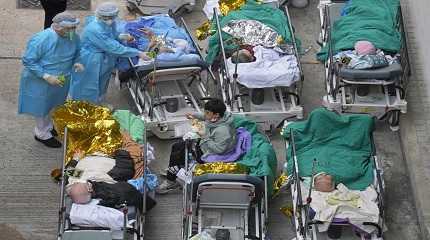
HONG KONG (AP) — Hospitals in Hong Kong were struggling Wednesday to keep up with an influx of new coronavirus patients amid record numbers of new infections as the city’s leadership doggedly sticks to its “zero-COVID” strategy, and China’s leader Xi Jinping said it was the local government’s “overriding task” to control the situation.
Hong Kong is facing its worst outbreak of the pandemic, topping 2,000 new COVID-19 cases per day this week. The city government has already instituted strict rules, banning gatherings of more than two households.
But health care facilities are beginning to overflow, forcing the city’s Caritas Medical Center on Wednesday to treat some patients in beds outside the building.
Xi personally issued instructions and directed Vice Premier Han Zheng to express to Hong Kong Chief Executive Carrie Lam the high level of concern Chinese Communist Party leaders had about the city’s ongoing outbreak, according to Wen Wei Po, a pro-Beijing news outlet.
Zheng stressed that the Hong Kong government “should earnestly assume the main responsibility, and regard the rapid stabilization and control of the epidemic as the current overriding task” to Lam, the outlet said.
Zheng said China’s central government agencies and neighboring Guangdong province would provide Hong Kong with resources to fight the outbreak, including rapid antigen tests, medical expertise and supplies.
China has been able to control the virus within its borders, maintaining a strict “zero-tolerance” policy that involves total lockdowns and mass testing millions of people.
Lam has also been sticking to the “zero-COVID” policy despite geographical and other differences between the city, a special administrative region, and China itself. The comments from Xi and Zheng were the latest pressure from Beijing for her to stay that course.
Practically, Hong Kong adopting the same approach means that travel between the city and the mainland remains subject to less stringent quarantine rules than the three weeks or more required for all foreigners arriving in the Chinese mainland.
Beijing will not let Hong Kong’s borders to the mainland reopen unless the city reaches and maintains zero COVID-19 cases.
The system seeks to contain and stop outbreaks as soon as they arise, with measures including snap lockdowns and extensive contact tracing. Last week, the entire upscale Discovery Bay neighborhood was ordered to undergo testing after authorities found traces of the virus in its sewage.
People who test positive are required to quarantine either in hospitals if they have serious symptoms or in government-run facilities for light or even no symptoms. The new record number of cases, driven by the highly transmissible omicron variant, has led to the current overcrowding.
By contrast, the city-state of Singapore, which is similarly sized to Hong Kong with a population of some 5.7 million compared to 7.5 million, undertook strict lockdown measures early in the pandemic but is now pursuing a “living with COVID” approach.
The number of new cases per capita in Singapore has skyrocketed with the arrival of omicron, with 1,911 new cases per million people reported on Monday, versus 66 per million in Hong Kong, according to Our World in Data.
But people testing positive who have no symptoms or only mild symptoms just need to self-quarantine at home, and even those who have more severe symptoms are told to see a physician for medical advice before going to the hospital.
Consequently, it is not suffering the stress on its health care system that Hong Kong is now experiencing.
Singapore also boasts one of the world’s highest vaccination rates, with 88% of its population fully vaccinated, compared to Hong Kong’s 64%.




